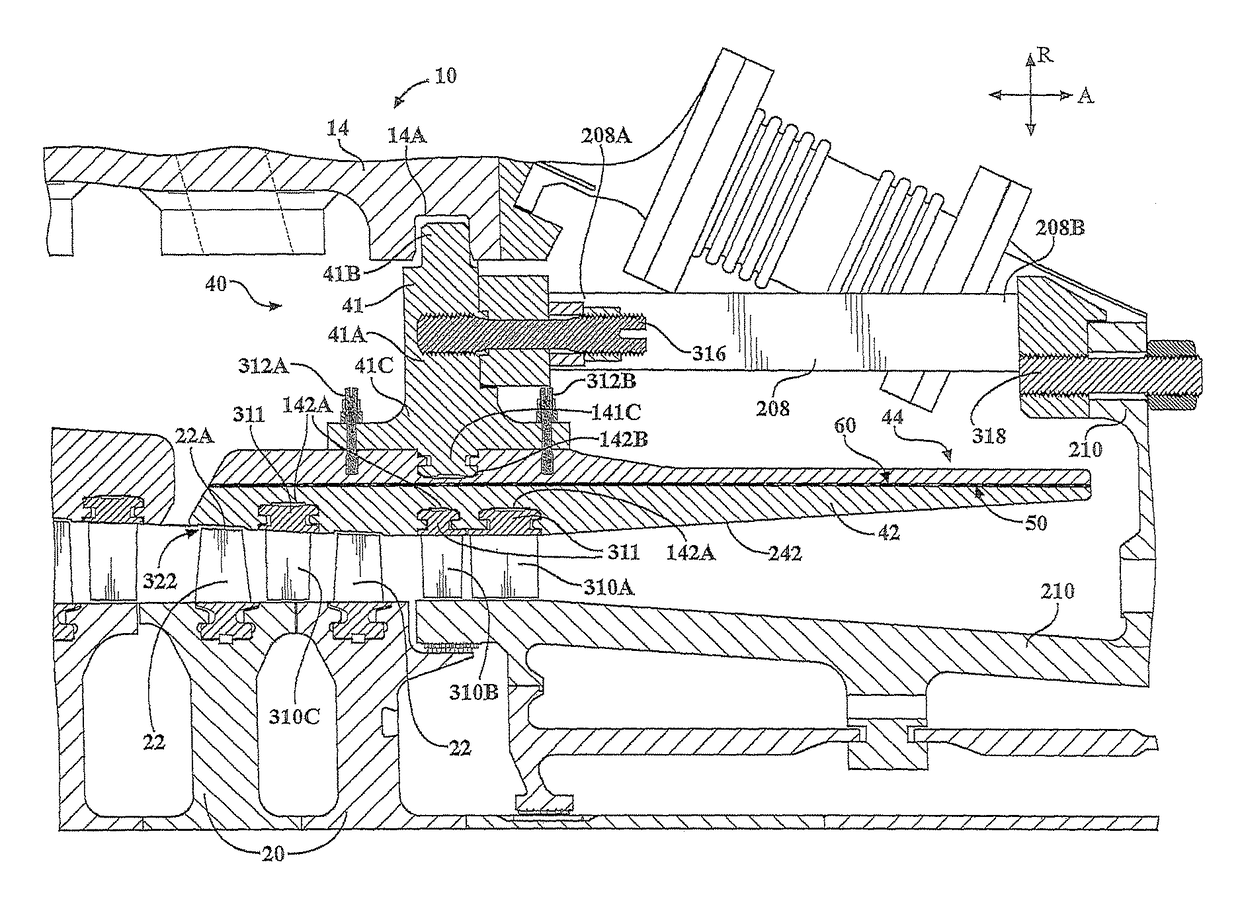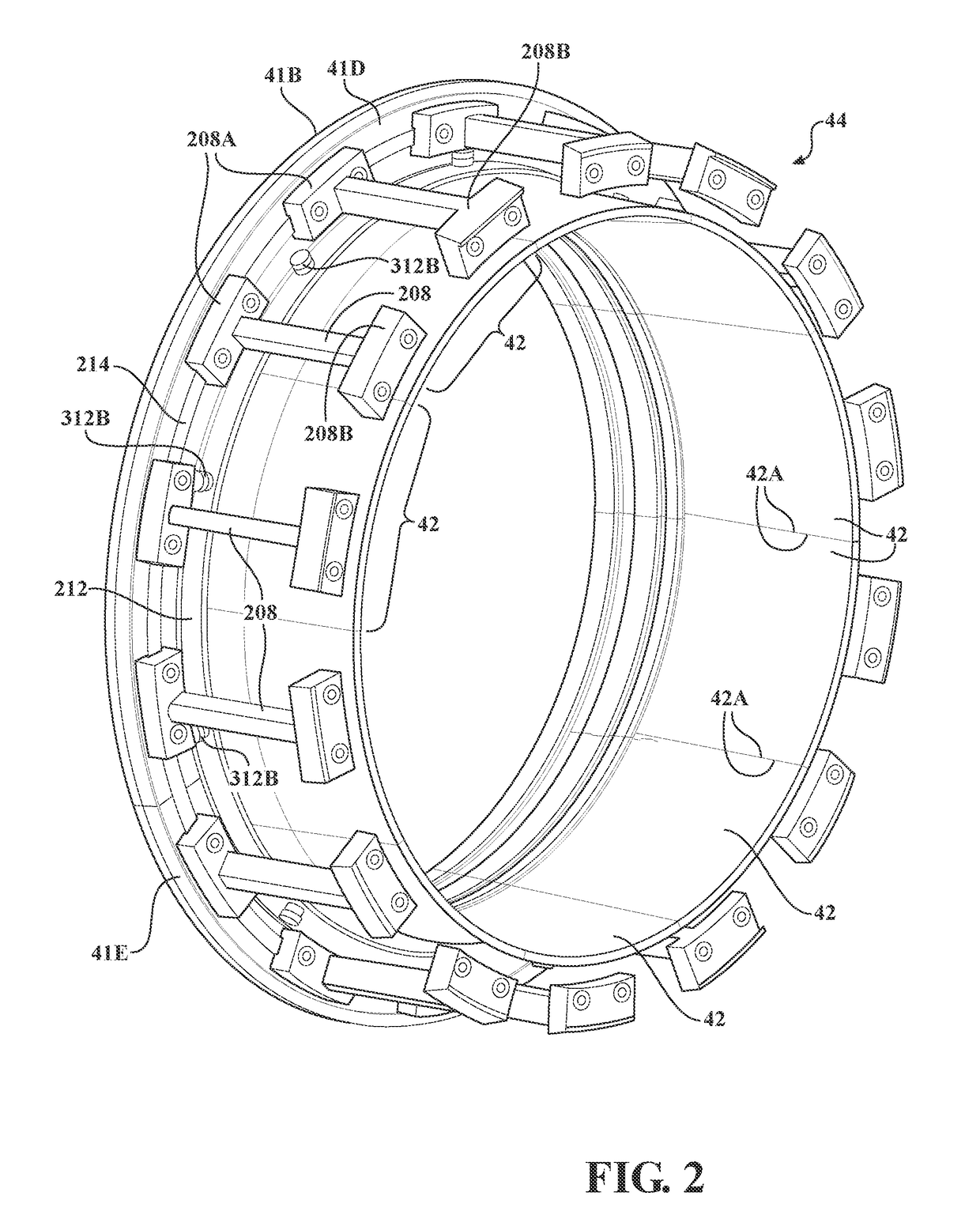Vane carrier assembly
a technology of vane carrier and assembly, which is applied in the direction of machines/engines, liquid fuel engines, lighting and heating apparatus, etc., can solve the problems of component or engine damage, engine operation efficiency reduction, etc., and achieve the effect of reducing thermal expansion
- Summary
- Abstract
- Description
- Claims
- Application Information
AI Technical Summary
Benefits of technology
Problems solved by technology
Method used
Image
Examples
first embodiment
[0028]In accordance with the present invention, a vane carrier assembly 40 is provided for supporting vanes 310A-310C within the engine outer casing 14, see FIGS. 1-2. The vane carrier assembly 40 comprises an annular control ring 41 and a plurality of vane support panels 42 coupled to the control ring 41. The control ring 41 comprises a main body 41A, a radial outer flange 41B and a radial inner coupling member 41C. The flange 41B is loosely received in an annular recess 14A provided in the engine casing 14. In accordance with the present invention, the control ring 41 is formed from a material having a coefficient of thermal expansion lower than that of the outer casing 14 and the main engine rotor. For example, the outer casing 14 may be formed from a conventional steel alloy such as 2.25 Cr—Mo steel, the components of the main engine rotor may be formed from a conventional steel alloy, such as a NiCrMo alloy, while the control ring 41 may be formed from a material, such as one o...
second embodiment
[0039]A vane carrier assembly 400 constructed in accordance with the present invention is illustrated in FIG. 4, where elements in the assembly 400 similar to those used in the assembly 40 illustrated in FIG. 1 are referenced by the same numerals as used in FIG. 1. In this embodiment, the control ring 410 has an axial dimension which is greater than its radial dimension. The control ring 410 is smaller than the control ring 41 in the FIG. 1 embodiment; hence, less low coefficient of thermal expansion material is required to form the control ring 410 of the FIG. 4 embodiment as compared to the control ring 41 of the FIG. 1 embodiment. The control ring 410 includes a flange 410B that is loosely received in an annular recess 140A provided in the engine casing 140. Because the control ring flange 410B is loosely received in the annular recess 140A of the engine casing 140, the engine casing 140 is capable of moving radially relative to the flange 410B of the control ring 410 during engi...
third embodiment
[0040]A vane carrier assembly 500 constructed in accordance with the present invention is illustrated in FIG. 5, where elements in the assembly 500 similar to those used in the assembly 40 illustrated in FIG. 1 are referenced by the same numerals as used in FIG. 1. In this embodiment, each of the vane support panels 540 includes a first section 504 and a second section 506. First, second and third rows of first, second and third vanes 310A-310C, respectively, are coupled to the vane support panel first sections 504, see FIG. 5. The first sections 504 are formed integral with a control ring 541 from a material, which preferably comprises a low coefficient of thermal expansion, such as one of INCOLOY® Alloy 909 (a nickel-iron-cobalt alloy), INCOLOY® Alloy 939 (a nickel based alloy), or NILO® Alloy K (a nickel-iron-cobalt controlled-expansion alloy). The control ring 541 includes a flange 541A that is loosely received in an annular recess 14A provided in the engine casing 14. Because t...
PUM
 Login to View More
Login to View More Abstract
Description
Claims
Application Information
 Login to View More
Login to View More - R&D
- Intellectual Property
- Life Sciences
- Materials
- Tech Scout
- Unparalleled Data Quality
- Higher Quality Content
- 60% Fewer Hallucinations
Browse by: Latest US Patents, China's latest patents, Technical Efficacy Thesaurus, Application Domain, Technology Topic, Popular Technical Reports.
© 2025 PatSnap. All rights reserved.Legal|Privacy policy|Modern Slavery Act Transparency Statement|Sitemap|About US| Contact US: help@patsnap.com



